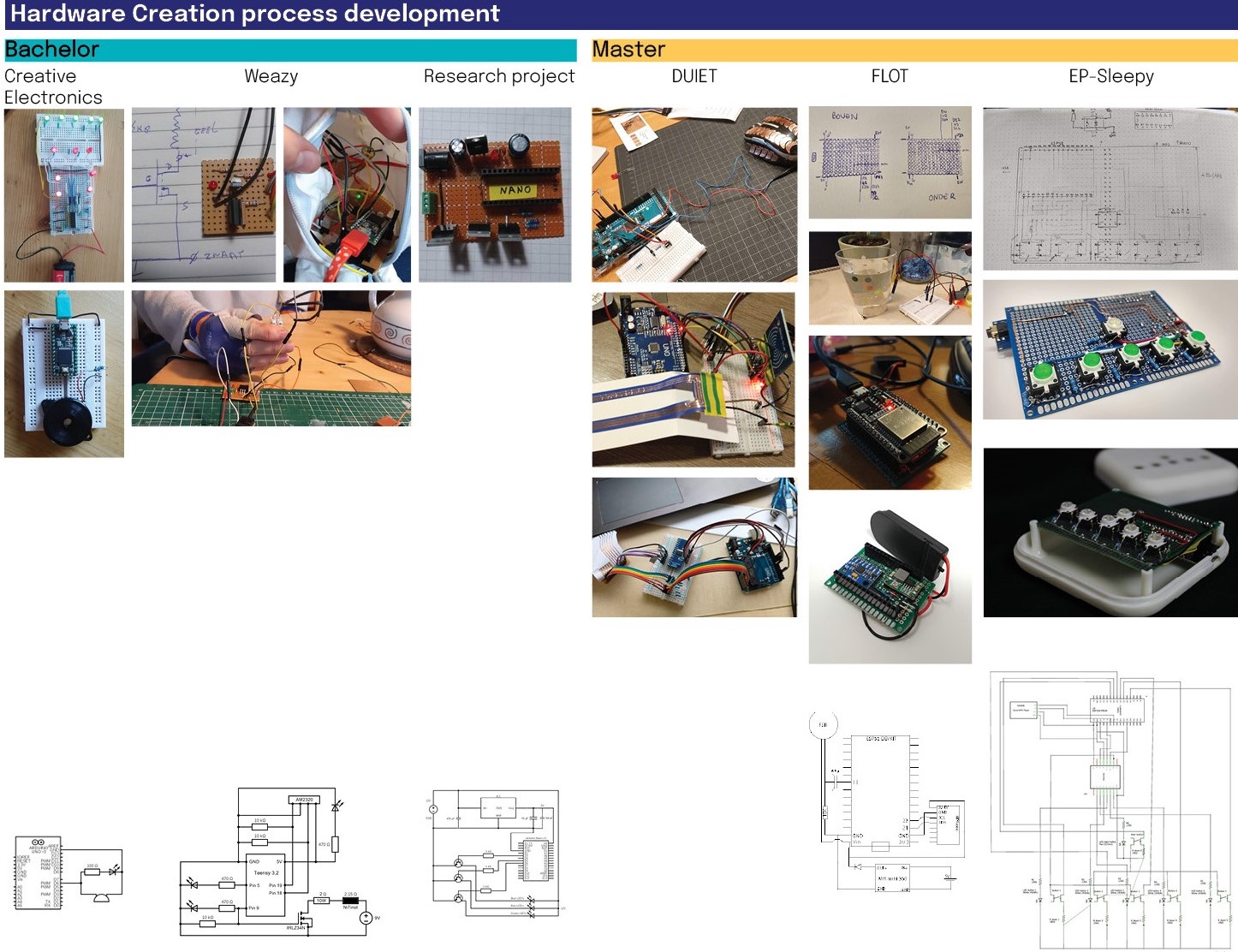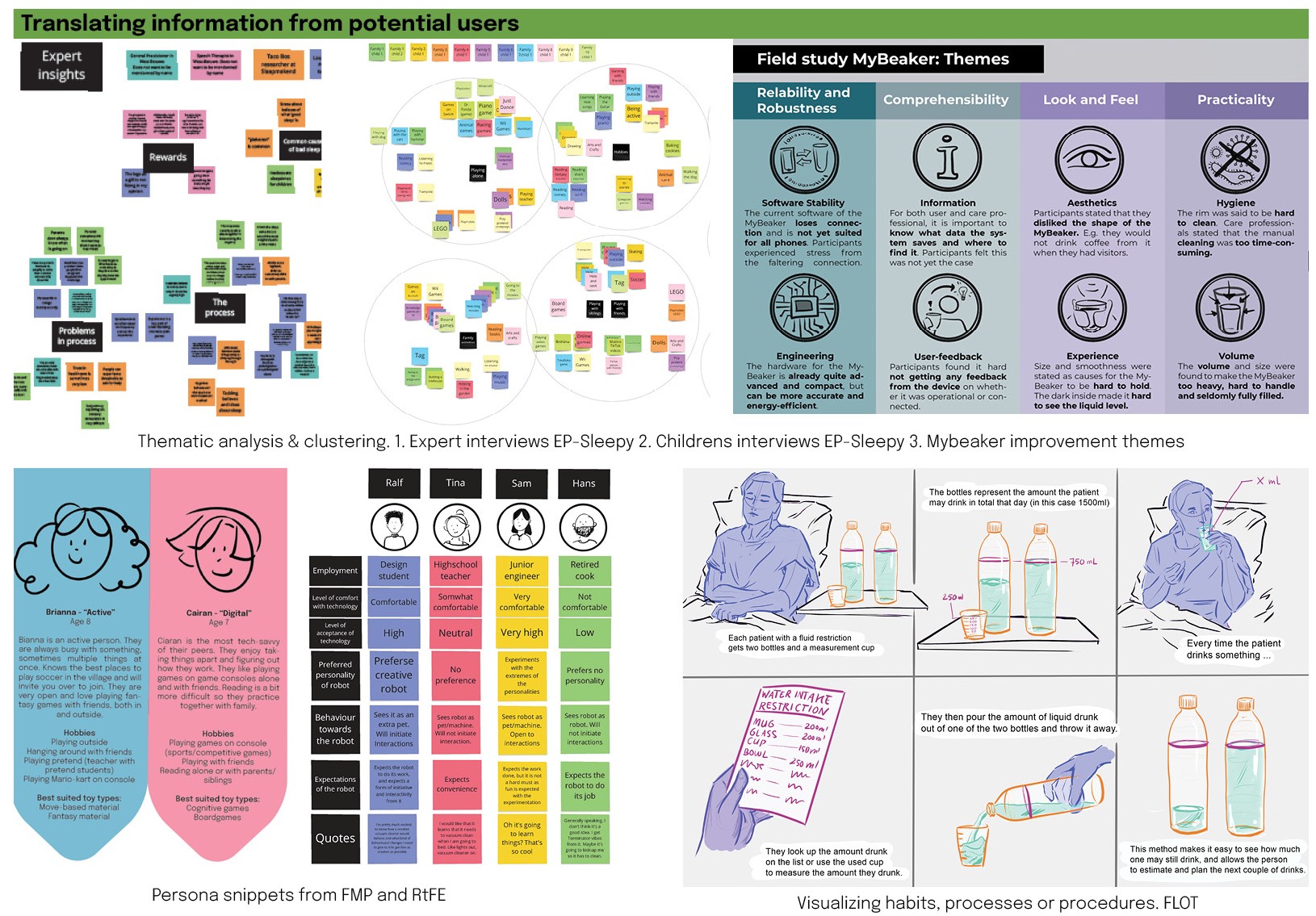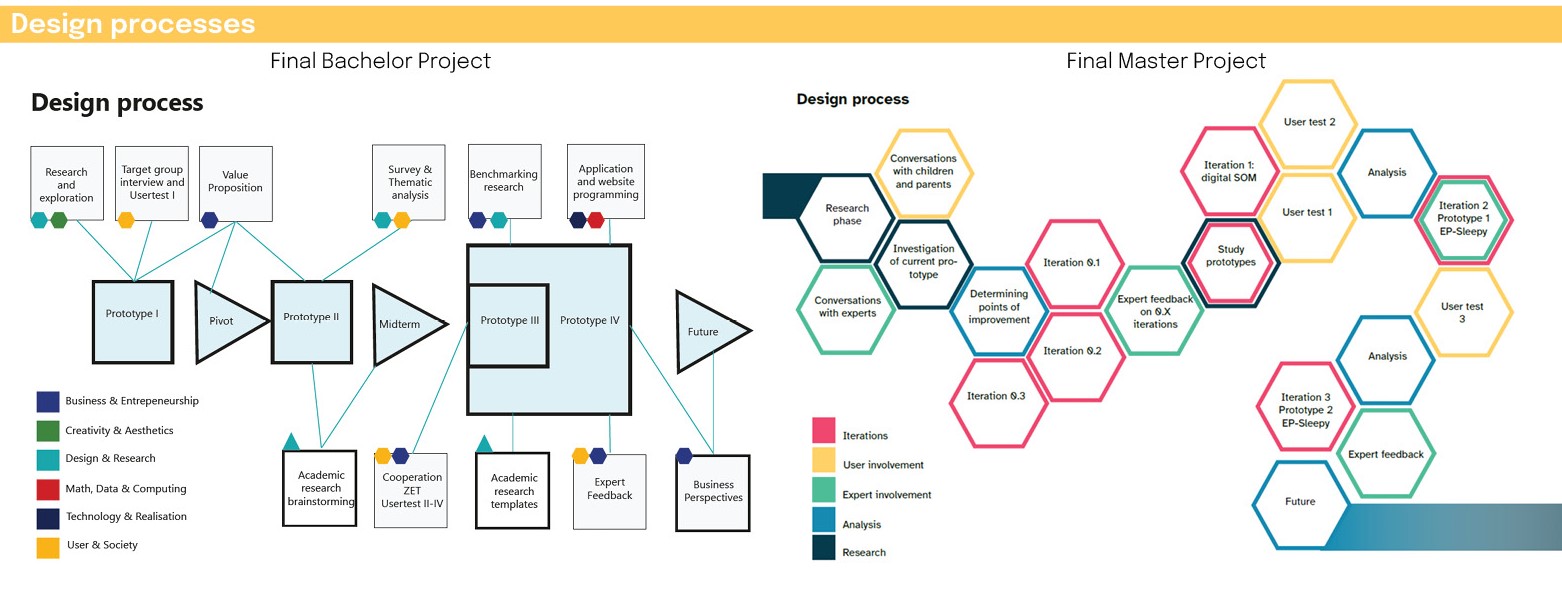Development
During my bachelor's, I got to take a broad approach to my studies to get a glimpse of all competencies and obtain a basis on which to build. After those three years, it was clear that my interest went out to the skills related to the Technology & Realization and User & Society competencies.
Firstly, US. Through UCD and HTI courses, I became fascinated by human behaviour and figuring out why we do the things we do. Secondly, people tend to tell me things. It is rare that I make a train journey or a trip to the mall without a stranger starting a conversation with me. While ‘skill’ is useful when contacting people, this does not mean I know how to listen actively or pose the right questions. So, to use this aspect of myself, I wanted to learn this, comfort those who share their feelings with me and know how to be empathic of the experiences they share with me and let them guide my design process.
My interest in TR is based on two things. I enjoy making things. Drawings, animations, d&d miniatures, maps, props, birdhouses, anything. I found the satisfaction in making a functional program and a device early on in my bachelor and since then, I took it upon myself to take care of the electronics. Secondly, creating prototypes of an idea makes it concrete. It shows options and makes conversing about complex topics easier, an even slightly interactive prototype makes a design come to life.
However, as these are not stand-alone competencies, I will discuss my overall development over the past two years concerning each of the competencies and how they overlap and complement one another.
Technology & Realization
Designing, building, testing and deploying prototypes to gather data, test user interactions or simply get the feel of a design come to life.
As stated in my Identity, I have always liked building and creating things. Through simply trying, I have become better at creating hardware, and software and tried my hand at several other creation processes.
Firstly, I have become more competent and confident in designing as well as creating systems, comparing the products from my bachelor's and master’s an improvement in design, wiring and soldering can be seen.
I started learning 3D modelling for FLOT, to create a mould for silicone. This skill took a long time to learn but proved very valuable. It was educative to apply these skills in a new project and context for my FMP where I could present a finished, deployed prototype with a 3D printed case.



To achieve my vision, I have become specialized in understanding the possibilities of (emerging) technologies, iterating ideas for application and running those past calculations, tests and experts to test for feasibility.
Additionally, I have learned to see the importance of understanding datasheets, underlying mechanisms in microcontrollers and most importantly documenting. Mostly in my FMP, I see growth in documenting more than just commenting on the code made. Via involvement with software engineers, optimization and refactoring of code were introduced to me. This is visible in the way my GitHub where I started using the platform to actually track my changes, instead of uploading the final code.
User & Society
Empathizing with people, understanding their subjective experiences, and adapting my design and prototypes to fit their daily lives.
Since starting my master's, I have been challenged with more and more complex use cases. Starting with a multi-user family system for Botano, followed by older adults in a healthcare setting for FLOT, and a device for children, EP-Sleepy. The variety of user groups was one of the reasons I chose not to continue with FLOT but tackle a new challenge with a demographic with vastly different needs and wants but also other technologies and I could learn more about how to continue working on an existing project.
In terms of user testing, the lockdown during ¾ of my master was hard but inspired innovation.
For example, the studies for RtFE were done completely digitally, and finding experts and user testers for FLOT was a challenge with hospitals and older adults being two of the most isolated places and individuals during the pandemic. This called for creativity and resourcefulness on my part, creating methods to involve potential users in the process.
I feel that my toolkit of approaching and involving users as well as my theoretical knowledge of their behaviours and experiences has been expanded. Courses like Design for Behavioural Change, Ethics of Technology and User Experience Theory and Practice all touch on experience, behaviour and effects of that behaviour. Now, as I gain more experience, talking with more people, trying out new methods or in a new sector, I will be able to link it to the theory and vice versa.


Math, Data and Computing
Gathering, understanding and filtering data to draw conclusions about functionalities of prototypes, experiences of users or the feasibility of designs.
Computing in the form of sensor noise reduction, data structuring and understanding algorithms have become more prevalent in my projects. My growth can be seen through the projects IIP, DUIET, Botano and FLOT. Where during IIP I first encountered algorithms, then the first attempts at applying them in Botano and DUIET, and finally in FLOT, where I created a classification algorithm. While not perfect, I have grown to better understand the possibilities and limitations of algorithms and feel more confident designing with them in future projects.
Finally, during research courses, I have attempted to become more fluent in statistical testing and the processing of quantitative data. Through courses outside of ID, such as Psychology of Light and Time, I got to work with different software like STATA and R, which has broadened my horizons.

Master: FLOT movement classification

Creativity & Aesthetics
The core of the creative design process, guided by research, the people involved and brought to life via low-fi and high-fi prototypes.
In the past year, I have started working on improving the aesthetics and interactions of users with the final product. For example, after FLOT, which worked but could not be deployed and did not look very finished, I set the goal for my FMP to make a prototype that could be deployed and that looked and felt like a finished prototype. I felt I needed to switch more to the ‘end-user’ perspective and be more critical of the aesthetics and the interaction with my digital and tangible prototypes. The difference between the FLOT and EP-Sleepy was immense.
Before, I have always stated that I enjoy communication with visuals. It helps me and others visualize an idea, and it can make complex topics easier (e.g. data structures or a protocol) to understand. However, throughout my master's, as more stakeholders got involved, I started using more diverse tools to help in the discussion and understanding of their perspectives. For example, foam models, computer renders or mock-up code.
CA, for me, represents the core of running a design project. Anything from researching related work, reading relevant studies to iterating testing the interactions with people to reflecting on and adjusting your course are covered in this competency. I always see this competency as closely connected to DRP, as new discoveries in both literature and through experience, feedback or user tests can shape and change the course you and your project are on. I have, over my masters, become more trusting of this process, especially through Botano, DUIET and EP-Sleepy. Letting go of some ideas while pursuing others is hard at first, but decisions must be made for a project to lead to a promising design and prototype.


Business & Entrepreneurship
Placing a design or prototype in the context of the real world, and understanding its value. Both in terms of money and its financial plan, and the added value it brings its users.
BE is not my field of interest. However, it is interwoven in any process that aims to have a connection to the real world. E.g. understanding the sector you are designing. EP-Sleepy and FLOT both are projects with a focus on healthcare, and this can be quite a difficult sector to innovate in.
Due to this, and the uncertainty concerning the pandemic, I have become more adept at giving space in my project for setbacks, either for extra time to find participants, developing remote methods of testing or prototype problems.
Finally, though I have always tried to identify and spot further development opportunities for each design I presented, this worked best in my final two projects, especially FLOT. The design and first prototype of FLOT were promising enough to present at the Wetenschaps Middag at the Maxima Medical Centre.

EP-Sleepy BMC

Design Research Processes
Framing your challenge, gaining an understanding of the context, needs and obstacles on your way. Continuously testing your assumptions, designs and ideas and letting findings of your and others’ research guide your decision-making. Seeing the broader context of results.
Though I would not position myself as a design researcher, research stays a key part of my projects. As stated under CA and US, literature and user tests help one take a different perspective on a topic. DRP for me is constantly gathering information and using it to adjust your view, validate your decisions, or otherwise guide your ideation processes.
Additionally, I feel that as I improved my documentation, I feel my reporting on a challenge has improved as well. A clear framing of a challenge, explanation of the situation and context of those involved are necessary to bring across your point. Which could either be, why your design is a possible solution, why your findings are valuable for further development or provide several designs to be studied further.
Either of these can then spark a new design or research project, either for yourself or others, to conduct.

Why we need EP-Sleepy pt 1

Why we need EP-Sleepy pt 2
Professional Skills
Eloquence in person and on paper.
The past two years have been impactful. Though I feel I have become more certain of myself and my abilities, the pandemic and online education have created setbacks for me. Presenting was never really my forte, but online presentations have not helped. Online and offline are so immensely different that the first offline/hybrid presentation felt like a huge disaster. Over the last half-year, I have tried to regain myself and become more comfortable presenting myself and my project. Even presenting FLOT to the MMC.
Through passing on and picking up projects from other students, I have seen what I would want in terms of documentation, and so have changed my own. As stated under DRP and TR, the clear framing of a problem, description of goals and your choices in the design process are necessary for others to understand your process and why your recommendations for further research or design approaches are valid.
Future
After completing this master's, I will continue with a Master's at the Eindhoven School of Education. I have two main reasons for this. First, gaining skills in education and facilitation, are useful when collaborating with people from different fields.
Secondly, I am interested in giving classes in Research & Design at middle schools. Through this, I will have the opportunity to teach and inspire youth to collaboratively problem-solve through research, thinking and iterating.
I see several possible career paths, but my focus will be on my second Masters for the next two years.

Reflecting
